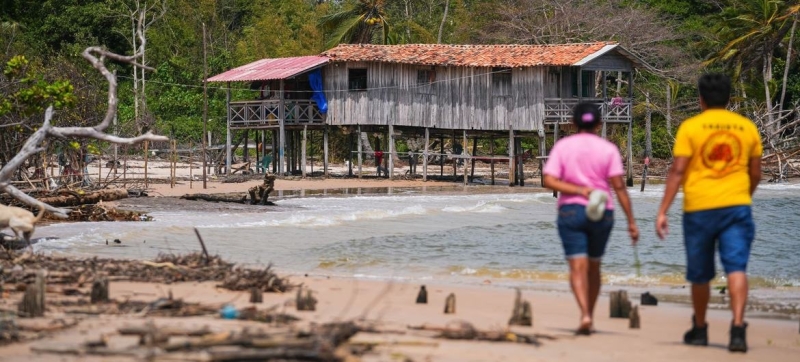- Developing countries united for a Just Transition Mechanism |
- UN Warns of Worsening Hunger Crisis Threatening Millions |
- Alamdanga’s disabled Zahurul sees the world through his hands |
- Touhid dismisses Indian media reports linking Dhaka for Delhi blast |
- IOM, HCI partner to combat human trafficking in Rohingya camps |
Rising Tides Force Brazil’s Vila do Pesqueiro Community to Adapt

Rising tides and coastal devastation have reshaped life in Marajó, washing away homes and livelihoods along the shore.
For more than 40 years, Ivanil lived in a house raised on stilts just 20 metres from the water’s edge, in the same community where she was born — Marajó Island, where the Amazon River meets the Atlantic Ocean in northern Brazil.
From there, she and her husband fished, planted crops, and raised animals. “I was a very happy person in that little piece of land — that was my paradise,” she says.
Then came the night that changed everything. Rain, thunder, and lightning tore through the darkness, shaking the small houses along the shore.
In Vila do Pesqueiro, a small traditional community facing accelerating tides and coastal erosion, families huddled together through the storm that would reshape their lives.
Nearly two years later, the memory remains vivid for Ivanil — every sound, every flash of lightning a reminder of how close the sea had crept.
When the tide swept through the community in February 2024, it claimed the land they had called home for generations. Ivanil and her neighbours had no choice but to abandon their houses and rebuild further inland. The distance was short — less than a kilometre — yet the change felt immense.
“Even though we didn’t move far, it feels like a completely different world,” Ivanil explained. “This is a mangrove area — hotter, noisier, and with no place where we can raise animals or grow crops.”
Vila do Pesqueiro is home to around 160 families within the Soure Marine Extractive Reserve, a protected area across the mouth of the Amazon River from Belém, where the international community is currently meeting at the UN Climate Change Conference (COP30). The displacement of people due to extreme weather and climate change is one of the key issues under discussion.
Reserves like Soure Marine are designed to safeguard the livelihoods and culture of traditional populations while promoting the sustainable use of natural resources. Fishing remains the community’s main source of income, while local gastronomy and small-scale tourism help families stay afloat.
Precarious existence
As the tides continue advancing, homes and livelihoods are increasingly fragile.
Next door to Ivanil lives her son, Jhonny, a fisher and university student who had just passed his entrance exam for a biology degree when the tide struck. He grew up watching the ocean change year after year, with stronger tides and faster erosion gradually reshaping the shoreline he once knew.
Jhonny recalls how quickly everything changed. Each season, the water crept a little closer until one day it reached their home. “The place where our houses used to be is now underwater,” he said.
He often thinks about the families still living by the water, aware that stronger tides are expected next year. “For me, moving isn’t just about safety,” he said. “It’s about protecting the place and the people who shaped my life.”

